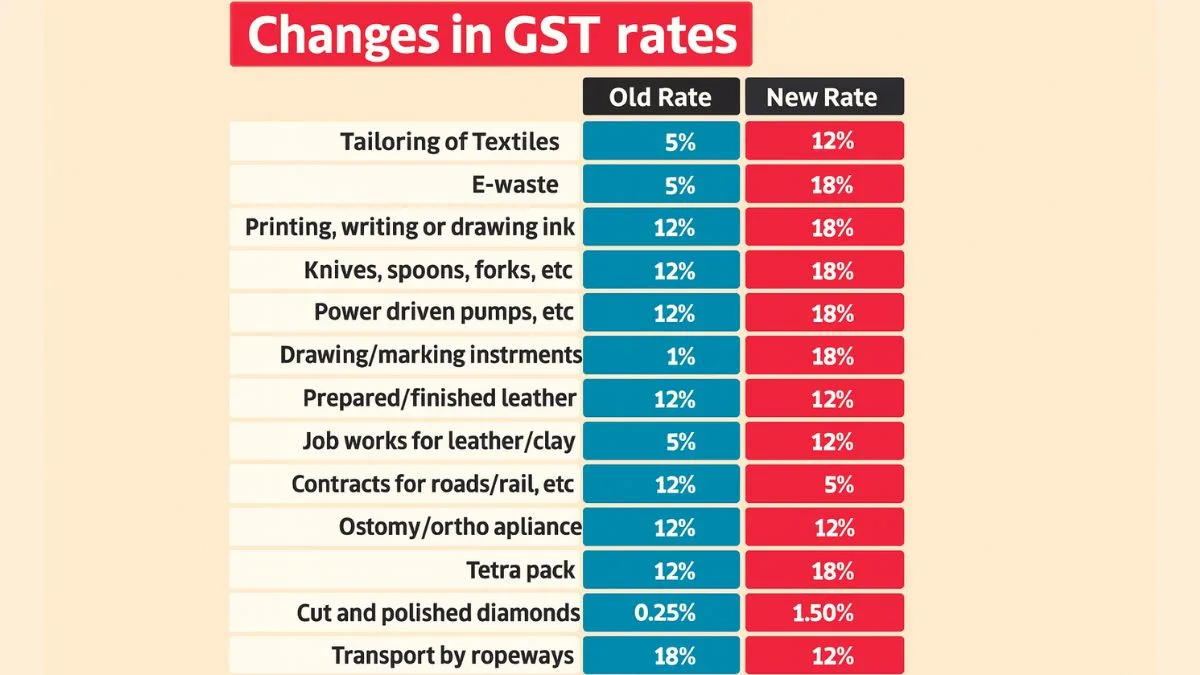
The Indian textile industry, one of the largest employers and exporters in the country, has long been vocal about the impact of GST rates on its value chain. In the latest decision, the GST Council announced revisions that have been welcomed by the sector. The textile industry hails revision of GST rates, particularly for creating uniformity across the textile value chain in both manmade fibre and cotton sectors.
While the revision brought relief, industry stakeholders expressed disappointment over the 18% duty on garments priced above ₹2,500 each. They argue this creates a disconnect in the otherwise streamlined tax structure.
The Positive Move: 5% Slab Extended to Garments Up to ₹2,500
One of the most significant highlights was the increase of the 5% limit for garments from ₹1,000 each to ₹2,500. This change is expected to directly benefit middle-class consumers, retailers, & manufacturers.
For years, garments priced above ₹1,000 were taxed at a higher slab, discouraging affordability in mid-range fashion. By raising the threshold to ₹2,500, the GST Council has made it possible for a wider range of apparel to remain in the 5% GST bracket, ensuring better accessibility for consumers and healthier margins for the industry.
Relief Across the Textile Value Chain
The textile industry has been lobbying for uniform GST across the value chain to avoid tax anomalies between raw materials & finished products. The latest decision, which aligns manmade fibre and cotton sectors under 5%, has been applauded."
This means that from fibre to yarn to fabric to garments, most products now enjoy the lower GST rate. The textile industry hails revision of GST rates as this step will minimize input credit blockages, ease compliance, & reduce costs for manufacturers.
The Anomaly: 18% Duty on Garments Above ₹2,500
Despite the positive steps, the industry is disappointed by the 18% duty on garments priced above ₹2,500. This slab continues to affect premium garments, wedding wear, and formal clothing categories.
The Cloth Manufacturers Association of India (CMAI) has highlighted that while almost the entire textile chain operates at 5%, garments above ₹2,500 remain the exception. Industry voices call this an “anomaly” and have urged the GST Council to revisit the decision.
Also Read: New GST Rates on All Cars: From Alto to Mahindra Thar and Tata Nexon
Industry’s Plea: Uniformity Needed
The CMAI & other associations have requested the government to either:
- Place all garments, irrespective of price, under 5%, or
- Fix a more reasonable threshold for the 18% duty, above ₹5,000 or higher, to reflect current market realities.
They argue that ₹2,500 is no longer a “luxury price point” given rising costs and inflation. A garment priced at ₹2,600 should not attract a disproportionately high tax compared to one priced at ₹2,400.
Impact on Consumers
For consumers, the revision means:
- Affordable fashion: More apparel now falls under the 5% GST bracket.
- Price-sensitive relief: Middle-class buyers can shop for better-quality garments without jumping to higher tax slabs.
- Luxury pinch: Garments priced above ₹2,500 may continue to feel expensive due to 18% duty, creating a barrier for aspirational shoppers.
This balance of relief and disappointment has created mixed reactions among end buyers.
Impact on Manufacturers and Retailers
Manufacturers and retailers have welcomed the GST relief but remain cautious:
- Lower working capital strain due to uniform tax on fibres & fabrics.
- Better compliance as input credit mismatches reduce."
- Strain on premium segment as 18% duty may affect sales of higher-value apparel, especially in urban markets."
The industry believes addressing the anomaly is key to sustaining growth across both affordable & premium categories.
Long-Term Benefits of GST Revision
Despite concerns, the textile sector expects positive long-term effects:
- Boost to domestic sales – Lower GST on mid-range garments will drive demand.
- Encouragement for exports – A uniform structure makes Indian textiles more competitive globally.
- Formalization of sector – Simplified GST rates reduce loopholes & tax evasion.
- Ease of business – From SMEs to large manufacturers, uniformity means simpler compliance.
The textile industry hails revision of GST rates as a step toward stabilizing one of India’s most vital sectors.
Also Read: GST Council’s Big Move: Tax Cuts on Medicines & Devices Promise Patient Relief
Voices from the Industry
Industry leaders have expressed a unified stance:
- “The increase of the 5% limit for garments from ₹1,000 each to ₹2,500 is a positive move,” said CMAI.
- “But having 18% duty on garments above ₹2,500 creates an uneven playing field in the textile value chain.”
The call is clear—remove the anomaly or revise the threshold further to reflect the true cost of garments in today’s economy.
Global Context: India’s Competitive Edge
Internationally, India competes with countries like Bangladesh and Vietnam in textiles. High GST on premium garments may weaken India’s competitiveness in the export market."
By maintaining a lower uniform GST rate, India could attract global buyers & strengthen its position as a leading textile hub. This is why the industry insists that the 18% duty on garments above ₹2,500 must be reconsidered.
Conclusion
The textile industry hails revision of GST rates, celebrating the uniformity across manmade fibre and cotton sectors and the relief of extending the 5% GST slab to garments priced up to ₹2,500. However, the 18% duty on garments above ₹2,500 remains a sore point.
The industry’s message is clear: while the Council has taken a progressive step, true relief will come when the entire textile chain, including premium garments, falls under the same rationalized GST structure.











